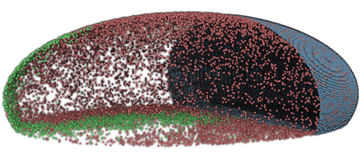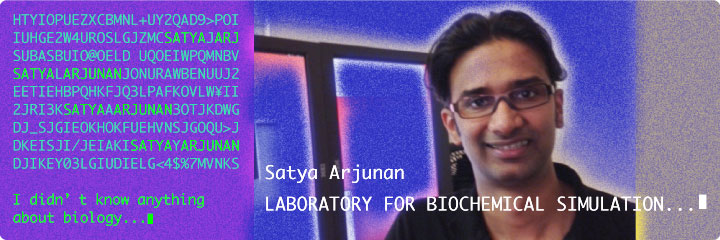TOP > News > Researcher Profile of the Month > Satya Arjunan
With degrees in computer science and electronic engineering from his home country of Malaysia and a desire to make a switch to the biological sciences, Satya Arjunan typifies the ideal researcher at QBiC. Although he “didn’t know anything about biology” when he graduated with his undergraduate degree, interest in artificial intelligence and regularly reading about biological and medical discoveries pushed him to consider his work in new ways. “I was working on protein structure prediction using machine learning approaches. The biology was just an application.” Still not satisfied, he searched on the internet for information on cell simulations and found an open source project called E-Cell at Keio University. The project was being run by Koichi Takahashi, now the Team Leader of the Laboratory for Biochemical Simulation, but only a Ph.D. student at the time.
Satya began working with E-Cell during his studies in 2002 even though it did not directly contribute to his work or graduation. “It was just my interest. E-Cell is a Linux program and I know Linux.” He contacted Takahashi that year and arranged to visit him in Singapore during a conference. Both were convinced they would benefit if Satya joined the Keio team, which Satya did in 2003. Shortly thereafter, though, Takahashi moved to the Molecular Sciences Institute in Berkeley, USA, for his post-doctorate, leaving Satya much more independent for his Ph.D. work than originally expected. Satya used that period to develop a reaction-diffusion simulator, Spatiocyte, which is also an open source project that runs with E-Cell and provides detailed intracellular spatial descriptions of molecules, allowing him to predict intracellular behavior at “resolutions up to a single molecule, with each molecule represented explicitly”. The two continued to work together despite being an ocean apart such that when Takahashi returned to Japan to start his own team, Satya immediately joined after completing his Ph.D and has remained ever since, including the move to QBiC in the institute’s inaugural year.

Simulation of PTEN (red) and PIP3 (green) waves in Dictyostelium discoideum using Spatiocyte. PTEN: phosphatase and tensin homolog, PIP3: phosphatidylinositol 3,4,5-trisphosphate.
Satya believes he has already benefited from the collaborative environment at QBiC. “It is much better here because I can talk to experimental biologists”. One example is the weekly meetings of 8-10 people that mix members of different labs. Regular and easy access to biologists has helped Satya explain what can sometimes appear as contradicting or unexpected observations in his simulations. At the same time, he has also been able to show how “very simple physical rules can bring out complex behavior” to biologists.
Even though it is new, Satya sees a lot of promise in QBiC and hopes to contribute to its nascent reputation. "I like my research work and life here. Japan has welcomed me and treated me really well for many years. I can’t see myself leaving anytime soon.”


